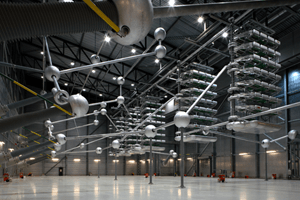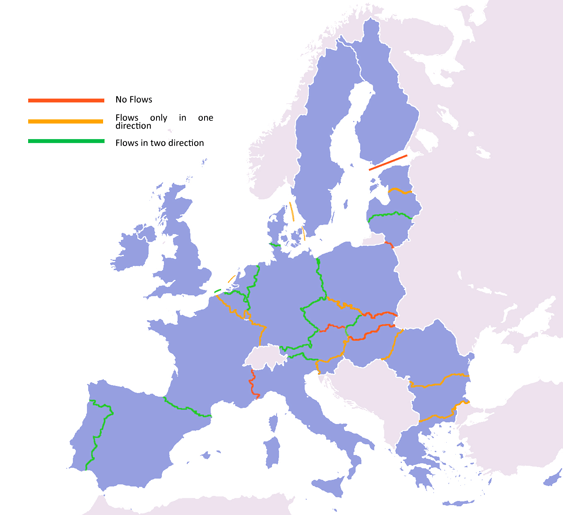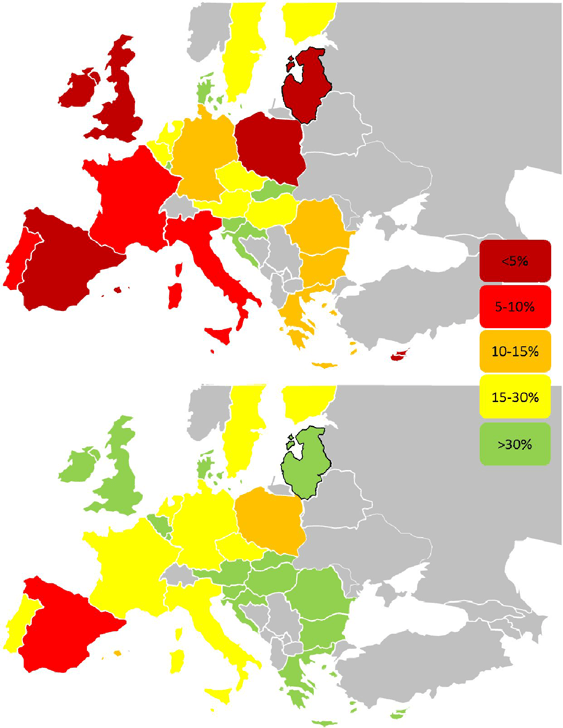All you need is interconnection, or the key to success (or failure) of the European energy policy
on
All you need is interconnection, or the key to success (or failure) of the European energy policy
The European energy policy has never been one of the success stories of the EU. However, while issues such as the external supply, the energy mix or the development of the single energy market have always been at the core of the discussion, energy interconnections, meaning infrastructural links for gas and electricity, have always had less relevance. An interconnected Europe is, however, the necessary condition for all the above to happen. Not by chance, both the President of the European Council Donald Tusk, when proposing the Energy Union, and the Commissioner Miguel Arias Cañete, when putting that into practice, strongly underlined the need for European energy infrastructures.
 |
| Inside the converter station (Eemshaven) of TenneT's NordNed cable, the subsea cable to Norway Source: tennet.eu |
Energy security is probably the strongest argument for gas interconnection, in particular concerning solidarity mechanisms. In case of disruptions of Russian gas, coordination of reserves, security of supply plans on the regional and the EU level will not work if the Member States simply have no pipelines to transmit their gas.
| Energy security is probably the strongest argument for gas interconnection |
 |
| Chart 1: Gas connections in Europe Source: Centre for European Studies (CEPS) |
The most important reason for energy interconnection is, however, the development of the single energy market, both for electricity and gas. It is simply impossible to imagine this in a Union where large economies such as the UK or Poland are as connected to the rest of Europe as Iceland, while several others, France and Italy among them, can transmit less than the 10% of their production capacity.
| The most important reason for energy interconnection is, however, the development of the single energy market |
It is clear that the case for European interconnections exists: how is the EU doing in this? We are afraid, not well.
Recently, Spain and Portugal failed to include a binding 15% target of interconnection in the 2030 Framework for Climate and Energy Policies, approved last year on October 23. The only result has been the European Council pressure on the Commission to take “urgent measures” to reach at least a minimum of 10% for Member States below that level by 2020.
 |
| Chart 2 - Electricity connections in Europe, as of 2013, and in case the Projects of Common Interest (PCI) would be fully implemented Source: EU Commission, 2013 |
However, a non-binding target is weak, considering the current situation. In 2002, the 10% interconnection target was set for 2005. As of 2013, 9 countries had still not met it, among which there are five of the seven largest power systems in Europe. Gas is not any better: while countries such as Italy and France are not connected between themselves, the majority of European connections allows no reverse flow, meaning that the gas can flow only in one direction.
The picture is best given by the most critical situations:
- France and the Baltic peninsula. A tiny 1400MW (1.5% of Spanish electricity production) connection makes the region virtually an energy island, wasting the significant solar and wind energy surplus Spain and Portugal currently benefit from.
- UK and the rest of Europe. Great Britain has very limited electrical connections (4GW), that cannot support its low production. Its capacity margin will be below 2% in one year. Despite the four pipelines, two with Norway and two with continental Europe, gas supply is insufficient for British demand, due to the decline in production. Energy prices are consequently higher than in the rest of Europe.
- The Baltic region. Four countries (Finland, Estonia, Latvia and Lithuania) are 100% reliant on Russian gas and connections are limited even among themselves. These countries are paradoxically readier to connect with the Russian power system than to the rest of the EU, from which they are almost isolated.
- Central Europe. Countries heavily reliant on Russian gas or particularly exposed to gas cuts, from Slovenia to Greece, have no possibility of reverse flow. Electricity connection with Central and Western Europe, Germany in particular, are small and inadequate.
While other Member States are hard to connect for geographical reasons (Malta, Cyprus), the situation sometimes gets worse when we consider the domestic picture of some countries. Italy, for instance, has good electrical connection in the north with France, Switzerland and minor ones with Slovenia and Austria, but its renewables –abundant Southern region is badly connected with the rest of the country.
The EU has tried hard to fight this situation, developing a large number of projects and institutions. The Commission 2050 Energy Roadmap, as well as the 2030 Green Paper, underline the importance of smart and connected networks. The European Council remarked this in 2002, 2011 and 2013. The Trans-European Projects (TEN) have a specific section for energy networks (TEN-E). Energy interconnections are also financed under the umbrella of the Projects of Common Interests (PCI). European Network of Transmission System Operators for Electricity (ENTSO-E) and for gas (ENTSO-G) develop European and regional level plans, and there are also several initiatives on the national level.
 |
| Chart 3 - Projects of Common Interest (PCI) for energy. In red gas, in blue electricity Source: EU Commission, 2014 |
Nonetheless, all these attempts have had a limited effect. The reasons are to be found in problems common to the whole European energy policy (governance, overlaps of institutions), as well as in a few issues, specific to the sector.
| increased interconnections are feared by national companies |
The main problem is, in fact, funding: in 2013, the Commission estimated the cost of the needed energy infrastructures in 200 billion euros, requesting up to 50% more investments from 2010 to 2020. Nonetheless, it is unclear who will pay for these: direct EU funding, through the Connecting Europe Facility (CEF) is a mere 5.85 billion euros. Meanwhile, energy demand is not growing and public and private funding is less and less available, especially for big projects.
Finding solutions is not easy, as we are at the very core of the success or failure of the whole European energy policy. There is some hope that the Juncker plan will change the situation, but little has been said about energy until now and mostly on energy efficiency. Regionalisation is an option, as it is easier to develop a policy and agree on projects with six or seven Member States than with twenty-eight. Nonetheless, the EU has already walked this way with the energy corridors or the Gas Regional Investment Plans (GRIPs) and we are still far from success. Liquefied natural gas (LNG) is also a possibility: last December Lithuania, fully reliant on Russian gas, received its first shipping of Norwegian gas. Infrastructures are, however, expensive and, while this source is valid for isolated areas as Sardinia or Corsica, it could hardly solve the structural problems of Europe.
The options are many and so are the reasons for increasing energy interconnections in Europe. The problem, as in many other cases, is the attitude of European countries. Connecting Member States is the very basis of a vision of a true European Union, from rails and roads to telecommunications. The question is whether this is what Europe truly wants or not. If Member States cannot agree on abolishing roaming fees, it is unclear how and if they will on 200 billion euros worth of energy projects.
Or maybe they will, after seeing their energy bill in ten years.


Discussion (0 comments)